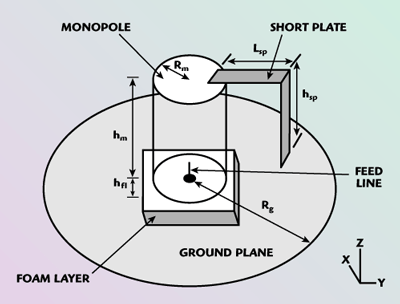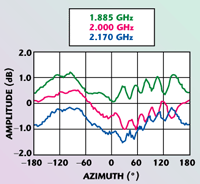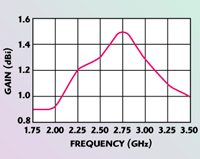A monopole antenna is a very simple and efficient radiating element.1 However, this antenna suffers from a limited bandwidth and distorted radiation characteristics. In the coming generation of mobile communications, multimedia services will be provided by a mobile handset, which must therefore be equipped with a broadband antenna. It is well known, however, that the smaller the size of the antenna, the lower the antenna efficiency and the narrower the bandwidth.2,3 Unfortunately, the radiation patterns of both a planar monopole antenna3–6 and a conventional monopole antenna3,7–9 are seen to be asymmetric or distorted. Moreover, the level of the distortions, or asymmetries, is greater at high frequency than in low frequency bands, which restricts their wide applications. A broadband characteristic and a high null in the E-plane radiation pattern were obtained with a sleeve monopole antenna.8 A low profile top-load monopole antenna was recently developed.3 It reduced the antenna size, but the H-plane radiation pattern showed a high null characteristic.
In this article, a low profile monopole antenna is proposed, with a shorted inverted L-shaped plate (SILSP) and a gap rectangular planar plate (GRPP), which has a wide-band and good radiation pattern characteristics. In this case, the SILSP of the proposed antenna leads to a decrease in the height of the monopole and helps the impedance matching in a usable frequency band. The GRPP reduces the null of the radiation pattern and helps the impedance matching. The measured radiation pattern of the proposed antenna is bi-conical and omni-directional without the distortions. The experimental bandwidth monopole with a gap and a short plate is approximately 45.5 percent (1.75 to 2.78 GHz) for a VSWR less than 2.0. Experimental results for the constructed prototype are introduced. In addition to the presented characteristics of a post-type monopole antenna without plates, those of an antenna with only a shorted plate are also detailed.
Antenna Structure and Experimental Results

Fig. 1 Monopole antenna with shorted and gap plates; (a) structure and (b) photograph.
The structure and a photograph of a proposed post-type monopole antenna with dual plates are shown in Figure 1. It consists of the post-type monopole, an inverted L-shaped aluminum plate, an additional rectangular gap plate and a circular ground plane. Rm is the radius of the monopole, hm is the height of the monopole, hfl is the height of a foam layer, and Lsp and hsp are the horizontal length and height of the inverted L-shaped plate, respectively. Wgp and hgp are the width and height of the gap rectangular plate, and Rg is the radius of the circular ground plane (reflector). The fabricated antenna dimensions are Rm = 8 mm, hm = 23 mm, hf l = 7.1 mm, Lsp = 9.8 mm, hsp = 30.1 mm, Wgp = 7.5 mm, hgp = 12.4 mm, Rg = 15.0 mm. The width of the ISLSP is 7.5 mm. The distance between the center of the post-type monopole and the center of the ISLSP is 11 mm. The distance between the center of the post-type monopole and the center of the GRPP is 15.8 mm. The characteristics of the antenna depend highly on the design parameters (Rm, hm, hfl, Lsp, hsp, Wgp, hgp, Rg). In addition, a shorting inverted L-shaped plate is attached between the end of the post-type monopole and the ground surface, and a 50 ? SMA connector is located away from the center of the z-axis to feed the antenna. The GRPP and the SILSP are used to reduce the distortion of the radiation patterns and improve the impedance matching. In this study, the circular ground plane is made of aluminum with a thickness of 0.5 mm. The post-type monopole is made of an aluminum rod with an 8 mm radius. The structure of a post-type monopole antenna with a single plate (SILSP only) is shown in Figure 2. It consists of the aluminum post-type monopole, a shorting plate, a foam layer, a circular ground plane and a 50 ? SMA connector. The impedance bandwidth of the antenna was measured with an HP8510 network analyzer and the far field patterns are measured inside a compact range available from the Hankook Antenna Co. The VSWR versus frequency is shown in Figure 3. The experimental bandwidth of monopole with only SILSP is approximately 39 percent (1.72 to 2.55 GHz) for a VSWR less than 2.0. The experimental bandwidth of the monopole with an SILSP and a GRPP is approximately 45.5 percent (1.75 to 2.78 GHz) for a VSWR less than 2.0.

Fig. 2 Structure of a monopole antenna with only the shorted plate.

Fig. 3 Measured VSWR versus frequency for the monopole antennas.
After the calibration was completed using a horn antenna, the far field radiation patterns were measured. An investigation of the radiation pattern characteristic of the post monopole using an SILSP and a GRPP has shown them to be similar to a conventional monopole. The x-z plane pattern is omni-directional without distortion, as illustrated in Figure 4.

Fig. 4 Measured x-z radiation pattern.
The radiation pattern characteristics of a planar monopole antenna3-6 and a conventional monopole antenna7–9 are seen to be asymmetric or distorted. However, the proposed antenna using a GRPP reduced the distortion of radiation pattern, as illustrated in Figure 5. The significant changes are an enhanced impedance matching and a reduced radiation pattern null. The measured x-z plane ripple for a proposed monopole antenna is shown in Figure 6, which has a relatively good radiation pattern.

Fig. 5 Measured y-z radiation pattern.

Fig. 6 Measured x-z plane ripple for a monopole antenna with dual plates.
The measured gain versus frequency in the x-z plane is shown in Figure 7. Because it is an omni-directional radiation pattern, the gain is relatively low over most of the band. The measured gain versus frequency in the y-z plane is shown in Figure 8. The gain is relatively higher over most of the band. This is probably due to the effect of the finite size of the antenna substrate, that is the power in the surface wave is not confined to the substrate but diffracted by the substrate edge, an effect that was not taken into account in the analysis. The measured peak gain is approximately 3.8 dBi near the center frequency, but drops off rapidly at the band edges. This is due to impedance mismatch and pattern degradation, as the back radiation level increases rapidly at these frequencies.

Fig. 7 Measured x-z plane gain.

Fig. 8 Measured y-z plane gain.
Conclusion
In this article, the experimental characteristics of a post-type monopole antenna with SILSP and GRPP plates have been studied. The E-plane radiation pattern characteristics of the asymmetric structure, planar monopole antenna and the conventional monopole antenna are observed to have an asymmetric, or distorted radiation pattern. The post-type monopole antenna with SILSP and GRPP has better radiation patterns than the conventional monopole. The added GRPP and SILSP are used to decrease the distortion of the radiation patterns and to improve the impedance matching, respectively. These lead to a good impedance matching over a wide frequency band. The experimental bandwidth monopole with a gap and a short plate is approximately 45.5 percent (1.75 to 2.78 GHz) for a VSWR less than 2.0. Since this antenna has an enhanced radiation pattern and a wide-band characteristic, it will be applied in wide-band and uniform density service systems in PCS, IMT-2000, WLL and other mobile communications.
References
1. M.W. Melvin, P.C. Stephen, C.L. Cho and J.W. Warren, Monopole Elements on Circular Ground Plane, Artech House Inc., Norwood, MA, 1987.
2. K. Fujimoto and J.R. James, Mobile Antenna Systems Handbook, Artech House Inc., Norwood, MA, 1994, pp. 65–70.
3. H. Jiang and H. Arai, “FDTD Analysis of Low Profile Top Loaded Monopole Antenna,” IEICE Transactions on Communications, E85-B (11), November 2002, pp. 2468–2475.
4. E. Lee, P.S. Hall and P. Gardner, “Dual-band Folded Monopole/Loop Antenna for Terrestrial Communication System,” Electronics Letters, Vol. 36, No. 24, November 2000, pp. 1990–1991.
5. M. Ali, M. Okoniewski, M.A. Stuchly and S.S. Stuchly, “A Dual-frequency Strip-sleeve Monopole Antenna for a Laptop Computer,” Proceedings of the IEEE Antennas and Propagation Society International Symposium, Vol. 2, June 1998.
6. C.T.P. Song, P.S. Hall, H. Ghafouri-Shiraz and D. Wake, “Multi-circular Loop Monopole Antenna,” Electronics Letters, Vol. 36, No. 5, March 2000, pp. 391–392.
7. K.A. Wagner and A.S. Gearhart, “A Novel Impedance Monopole Antenna,” Radio Science, Vol. 33, No. 1, February 1998, pp. 1–6.
8. J.I. Moon, S.O. Park and K.Y. Park, “Broadband Sleeve Monopole Antenna for Dual-band PCS/IMT-2000,” Electronics Letters, Vol. 36, No. 22, October 2000, pp. 1829–1830.
9. Z.N. Chen, K. Hirasawa and K. Wu, “A Novel Top-sleeve Monopole in Two Parallel Plates,” IEEE Transactions on Antennas & Propagation, Vol. 49, No. 3, March 2001, pp. 438–443.
